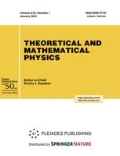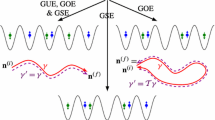Abstract
We present two ways to obtain precise expressions for the commuting Hamiltonians of the integrable system regarded as a fermionic limit of the quantum Calogero–Sutherland system as the number of particles tends to infinity with some special values of the coupling constant \(\beta\). The construction is realized in the Fock space.
Similar content being viewed by others
References
D. Bernard, M. Gaudin, F. D. M. Haldane, and V. Pasquier, “Yang–Baxter equation in spin chains with long range interactions,” J. Phys. A: Math. Gen., 26, 5219–5236 (1993).
Y. Kato and Y. Kuramoto, “Exact solution of the Sutherland model with arbitrary internal symmetry,” Phys. Rev. Lett., 74, 1222–1225 (1995); arXiv:cond-mat/9409031v2 (1994).
C. F. Dunkl, “Differential-difference operators associated to reflection groups,” Trans. Amer. Math. Soc., 311, 167–183 (1989).
G. J. Heckman, “An elementary approach to the hypergeometric shift operators of Opdam,” Invent. Math., 103, 341–350 (1991).
A. P. Polychronakos, “Exchange operator formalism for integrable systems of particles,” Phys. Rev. Lett., 69, 703–705 (1992).
I. Andrić, A. Jevicki, and H. Levine, “On the large-\(N\) limit in symplectic matrix models,” Nucl. Phys. B, 215, 307–315 (1983).
H. Awata, Y. Matsuo, S. Odake, and J. Shiraishi, “Collective field theory, Calogero–Sutherland model, and generalized matrix models,” Phys. Lett. B, 347, 49–55 (1995); arXiv:hep-th/9411053v3 (1994).
H. Awata, Y. Matsuo, and T. Yamamoto, “Collective field description of spin Calogero–Sutherland models,” J. Phys. A, 29, 3089–3098 (1996); arXiv:hep-th/9512065v3 (1995).
I. G. Macdonald, Symmetric Functions and Hall Polynomials, Oxford Univ. Press, Oxford (1998).
M. L. Nazarov and E. K. Sklyanin, “Integrable hierarchy of the quantum Benjamin–Ono equation,” SIGMA, 9, 078 (2013); arXiv:1309.6464v2 [nlin.SI] (2013).
A. N. Sergeev and A. P. Veselov, “Dunkl operators at infinity and Calogero–Moser systems,” Internat. Math. Res. Notices, 2015, 10959–10986 (2015).
A. G. Abanov and P. B. Wiegmann, “Quantum hydrodynamics, the quantum Benjamin–Ono equation, and the Calogero model,” Phys. Rev. Lett., 95, 076402 (2005); arXiv:cond-mat/0504041v1 (2005).
A. P. Polychronakos, “Waves and solitons in the continuum limit of the Calogero–Sutherland model,” Phys. Rev. Lett., 74, 5153–5157 (1995).
S. M. Khoroshkin and M. G. Matushko, “Fermionic limit of the Calogero–Sutherland system,” J. Math. Phys., 60, 071706 (2019).
A. K. Pogrebkov, “Boson–fermion correspondence and quantum integrable and dispersionless models,” Russian Math. Surveys, 58, 1003–1037 (2003).
P. Rossi, “Gromov–Witten invariants of target curves via symplectic field theory,” J. Geom. Phys., 58, 931–941 (2008).
A. Alexandrov and A. Zabrodin, “Free fermions and tau-functions,” J. Geom. Phys., 67, 37–80 (2013).
V. G. Kac, A. K. Raina, and N. Rozhkovskaya, Bombay Lectures on Highest Weight Representations of Infinite Dimensional Lie Algebras (Adv. Ser. Math. Phys., Vol. 29), World Scientific, Singapore (2013).
Acknowledgments
The author thanks S. M. Khoroshkin and A. K. Pogrebkov for the valuable remarks and fruitful discussions on the subject of the paper.
Funding
This research was supported by a grant from the Russian Science Foundation (Project No. 20-41-09009) and by the Simons Foundation.
Author information
Authors and Affiliations
Corresponding author
Ethics declarations
The author declares no conflicts of interest.
Appendix
It was proved in Proposition 2 that the densities \( \mathcal{W} _k(z)\) are linearly expressed in terms of \(w_n(z)\) given by (3.13). The first densities \(w_n(z)\) are given in Sec. 3.3. Here, we present the expressions for the first densities \( \mathcal{W} _k(z)\),
Rights and permissions
About this article
Cite this article
Matushko, M.G. Calogero–Sutherland system at a free fermion point. Theor Math Phys 205, 1593–1610 (2020). https://doi.org/10.1134/S0040577920120041
Received:
Revised:
Accepted:
Published:
Issue Date:
DOI: https://doi.org/10.1134/S0040577920120041



